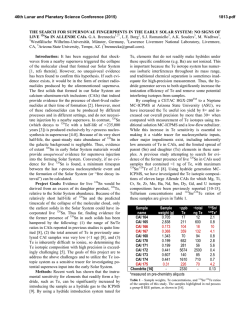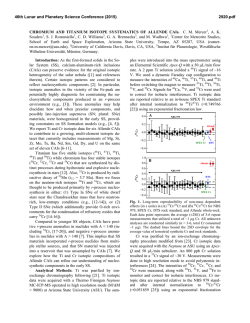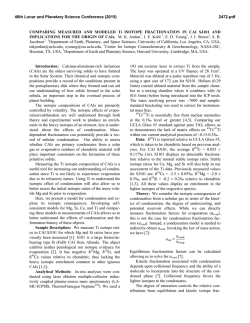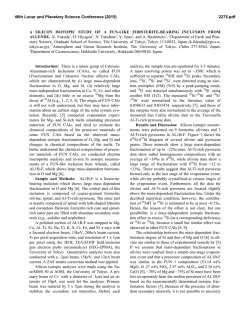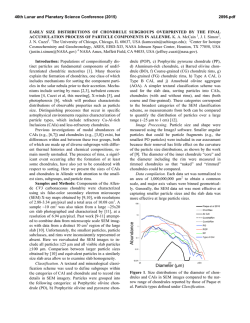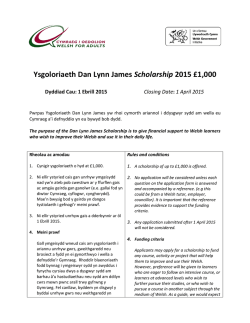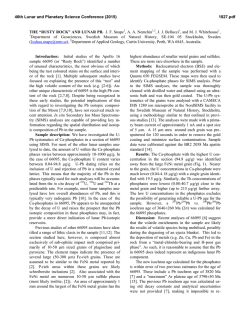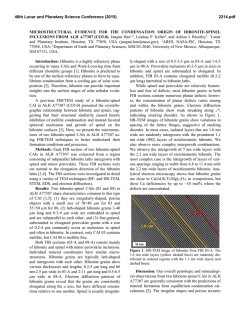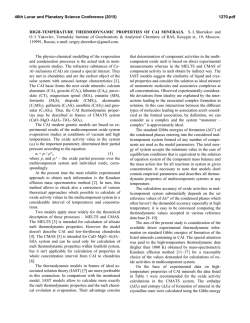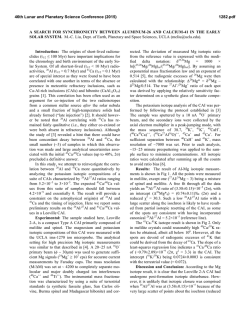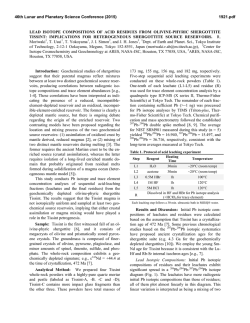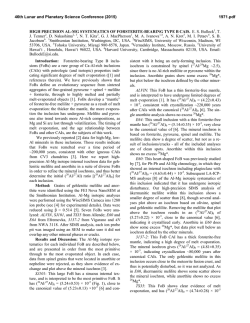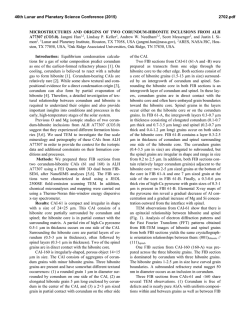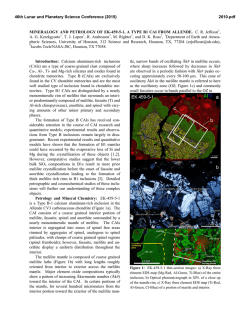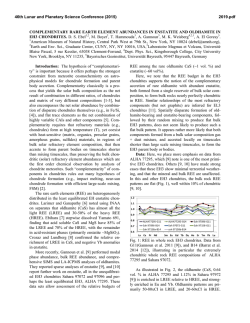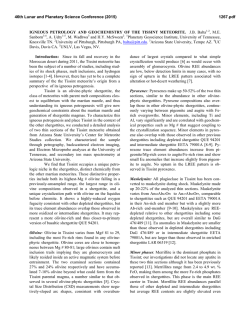
U-Th-Pb AND Rb-Sr SYSTEMATICS OF ALLENDE FUN CAI CMS-1
46th Lunar and Planetary Science Conference (2015) 2355.pdf U-Th-Pb AND Rb-Sr SYSTEMATICS OF ALLENDE FUN CAI CMS-1. Y. Amelin1, C. D. Williams2,3 and M. Wadhwa2, 1Research School of Earth Sciences, Australian National University, Canberra, Australia ([email protected]), 2School of Earth and Space Exploration, Arizona State University, Tempe, AZ 852871404, USA, 3Department of Earth and Planetary Sciences, University of California at Davis, CA 95616, USA. Introduction: Among the calcium-aluminum-rich inclusions (CAIs) there exists a small subgroup referred to as FUN CAIs (for Fractionation and Unidentified Nuclear effects [1]) that exhibit unusually large mass-dependent fractionations and mass-independent isotopic variations [1-3]. Understanding the origin, conditions of formation, genetic relationship of these inclusions with other CAIs and the time of formation has been hampered by the rarity of these objects: since the first discovery of two FUN CAIs 37 years ago [1], only about 20 such CAIs have been identified [3-4].. Variable and mostly low compared to “normal” CAIs 26Al/27Al in FUN CAIs derived from their internal 26Al-26Mg isochrons [4, 5] suggests that these CAIs formed either prior to, or simultaneously with, injection and homogenization of freshly synthesized 26Al into the protosolar nebula [6]. Alternatively, the FUN CAIs could have formed significantly later, or experienced widespread resetting of the 26Al-26Mg isotopic system. A recent investigation of the 182Hf-182W relative chronometer in a single FUN CAI pointed to its formation contemporaneously with other CAIs in the nebula, and additionally suggested heterogeneous distribution of 26Al [7]. The uncertainty in the formation age of FUN CAIs could be resolved by dating with the U-Pb isotopic chronometer, but such determinations have been precluded by very low concentrations of U [7, 8]. Furthermore, only a few of the identified FUN CAIs are large enough to be analyzed for multiple geochemical and isotopic systems, especially isotopic dating using macroscopic (more precise but destructive) methods. Here we report preliminary U-Th-Pb and RbSr data for a recently discovered FUN CAI (CMS-1) discovered in the Allende meteorite. Sample: Allende FUN CAI CMS-1 is an irregularly shaped compact Type A inclusion. Its primary mineralogy consists of Ti-Al-rich pyroxene, melilite, abundant inclusions of spinel [4, 9]. Previous studies have reported on its Ti, Si, Mg, O isotopic compositions [4,9-10] as well as REE microdistributions [11]. The bulk REE pattern (based on estimated modal abundances of phases) is relatively flat with a small negative Ce anomaly and is enriched ~20× relative to CI chondrites [11]. Methods: A ~5 mg piece was gently crushed in a mortar and pestle. Coarse (>100 µm, 2.33 mg) and fine (2.00 mg) fractions were separated for U-Pb isotope analyses. These fractions were sequentially leached in cold dilute HNO3 (W1), hot 6M HCl (W2) and hot dilute HF (W3), leaving the residue (R) that was dissolved in hot concentrated HF. The leachates and the residues were spiked with 202Pb-205Pb-229Th-233U-236U, and Pb, U and Th were separated and analyzed using procedures similar to [12, 13]. The bulks after U, Th separation were spiked and further analysed for Rb-Sr isotopes using the procedures of [14]. Results: Uranium concentrations were calculated by numeric recombination of the leachates and residues. The recombined U concentration in the coarse fraction is 1.2 ppb, while the fine fraction contains 1.8 ppb; these concentrations are 30-100 times lower than in “normal” CAIs. A large portion (69-76%) of the U is located within the easily soluble fraction, notably W1. All other fractions contain less than 0.2 ppb U. Since easily leachable U is likely to be partially transferred from the matrix and/or introduced by handling, 1.2 ppb is considered an upper limit for the U concentration in this CAI. The total (recombined) concentration of Th is 440620 ppb, consistent with the ~20x enrichment (relative to CI) in REE [11]. Th is distributed uniformly throughout all leaching steps. Assuming that the parent material of this CAI had a CI-like Th/U ratio (~4), its original U concentration is expected to be 100-150 ppb U, typical for “normal” CAIs. Lead isotope ratios associated with the 238U-206Pb and 235U-207Pb decay schemes (Fig.1) are rather un- Figure 1. 207Pb/206Pb vs. 204Pb/206Pb isochron for the washes and residues of the CAI CMS-1. radiogenic (206Pb/204Pb between 10.6 and 16.8 for the leachates, and close to 15 for the residues) and are consistent with mixing between radiogenic Pb produced 46th Lunar and Planetary Science Conference (2015) by the decay of the small amount of U present in the sample and primordial Pb, or Pb transferred from the matrix into the inclusion. There is no evidence for any modern terrestrial contamination. The y-intercept of the 207Pb/206Pb vs. 204Pb/206Pb linear array (if interpreted as an isochron) corresponds to an age of 4586±79 Ma when calculated using 238U/235U=137.79 (the true 238 U/235U could not be determined due to very small quantity of U available). This age is consistent with the age of “normal” CAIs, but is too imprecise to provide a useful constraint on the time of formation for CAI CMS-1, or FUN CAIs in general. In contrast to the radiogenic ratios in the U-Pb system, the isotope ratios associated with the 232Th-208Pb system are much more radiogenic (208Pb/204Pb between 53 and 451 in the leachates and 734-788 in the residues). The possibility of using this system for age determination is, however, comptomised by possible fractionation between Th and radiogenic Pb, both natural and induced by leaching. Figure 2. 87Sr/86Sr vs. 87Rb/86Sr isochron for the leachates and residues of the CAI CMS-1. Reference line corresponds to the radiogenic growth of 87Sr over 4567 Ma. The Rb-Sr data for three leachates and residue of the coarse fraction show some scatter in the isochron diagram (Fig. 2) and yield apparent initial 87Sr/86Sr between 0.69839 and 0.69900. The scatter is possibly caused by Rb-Sr fractionation during leaching, in particular in the last (HF) leaching step. The re-combined initial 87Sr/86Sr of 0.69884 agrees with the lowest initial 87Sr/86Sr reported for “normal” CAIs [15]. The 84Sr/86Sr data, normalized to 86Sr/88Sr=0.1194, are shown in Fig. 3 in comparison with values for leachates (Wash 1 and 2) and residues for “normal” CAIs from the chondrite NWA 4502 [14]. The leachates and residues of CMS-1 show a consistent deficit of 84 Sr of 5ε (relative to the SRM987 standard), which is identical to the 84Sr deficit reported for the Allende FUN CAI C1 [16]. Whether this apparent deficit is real or is caused by an anomaly in 88Sr (which is one of the normalizing isotopes for the fractionation correction) is being investigated. The uniformity of the 84Sr/86Sr ratio between the fractions is important because it indicates 2355.pdf Figure 3. 84Sr/86Sr ratios in the Allende CAI CMS-1 (this study) and CAIs from the CV chondrite NWA 4502 [14]. limited extent, or absence, of Sr isotope exchange between the CAI and the matrix. Discussion: One of the most intriguing observations in this study is the evidence for extreme elemental fractionation between REE and Th, on one hand, and U, on the other. Considering “flat” distribution pattern of REE [9], this fractionation is unlikely to be caused by evaporation and/or condensation processes and the difference in volatility. Nucleosynthetic origin of low U abundance is also unlikely, since U and Th are thought to be produced in the same rprocess, and the ratio of their yields have little dependence on the conditions, e.g. neutron flux [17, 18]. In terrestrial surface environments, U is known to very efficiently fractionate from REE, Th and other elements by leaching under high oxygen fugacity [e.g. 19]. Similar interaction with an aqueous fluid in the nebular environment, either in the protosolar nebula or near the place of primary condensation, could have caused U removal from the parent material of the FUN CAIs. Although the reason for the measured depletion in U is not clear at present, it is noted that the ~5 mg fraction of CMS-1 analyzed thus far may not be representative of the bulk inclusion. Further analyses will be required to address this issue. References: [1] Wasserburg G.J. et al. (1977) GRL 4, 299-302. [2] Papanastassiou D.A. & Brigham C.A. (1989) ApJ 338, L37–L40. [3] Krot A.N. et al. (2014) GCA 145, 206–247. [4] Williams C.D. et al. (2012) 75th MetSoc Abstract #5102. [5] Park C. et al. (2013) 76th MetSoc Abstract #5085. [6] Sahijpal S. & Goswami J.N. (1998) ApJ 509, L137–L140. [7] Holst J.C. et al. (2013) PNAS 110, no. 22, 8819–8823. [8] Chen J.H. & Wasserburg G.J. (1981) EPSL 52, 1-15. [9] Williams C.D. et al. (2013) LPS 44, Abstract # 2435. [10] Williams C.D. et al. (2014) LPS 45, Abstract #2146. [11] Williams C.D. et al. (2013) 76th MetSoc, Abstract #5108. [12] Amelin Y. et al. (2010) EPSL 300, 343350. [13] Amelin Y. et al. (2013) LPS 44, Abstract #2690. [14] Amelin Y. et al. (2014) 77th MetSoc, Abstract # 5244. [15] Gray C.M. et al. (1973) Icarus 20, 213-239. [16] Papanastassiou D.A. & Wasserburg G.J. (1978) GRL 5, 595598. [17] Goriely S. and Arnould M. (2001) AA 379, 11131122. [18] Lingenfelter R.E. et al. (2003) ApJ 591, 228-237. [19] Neymark L.A. & Amelin Y. (2008) GCA 72, 2067– 2089.
© Copyright 2025
